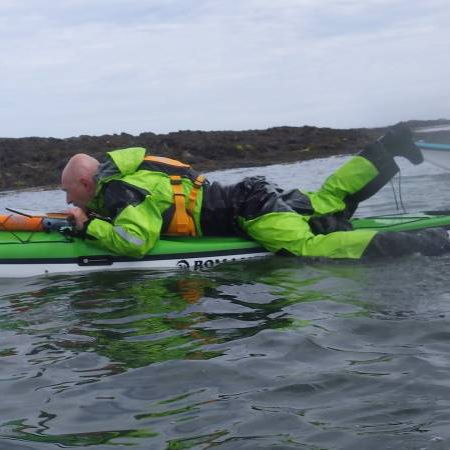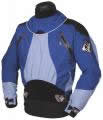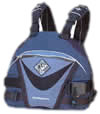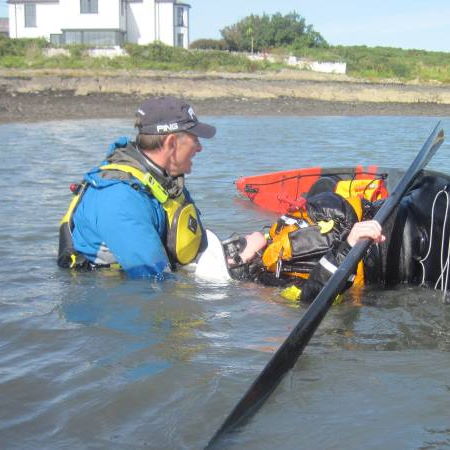Equipment
If you decide to take the sport further than a few taster sessions, then you will really need to think about getting gear – this usually is a wetsuit and some sort of paddling top (cag) – at BKC we have a number of river kayaks and sea kayaks, all with associated spraydecks, helmets and paddles, for people without their own boats to use, but we do not have personal clothing to lend out.
The essential bits of equipment for kayaking and which you will have to purchase are:
- some sort of kayak
- a neoprene spray deck
- a paddle
- a buoyancy aid
- a cag and wetsuit (a long john wetsuit is best – it has no arms)
- a helmet if paddling in rivers or – later in your kayaking career – in surf
although it is perfectly possible to paddle for at least a year using borrowed equipment to see if you like kayaking – and if it likes you!
| Belfast Kayak Club Boats | |
|---|---|
| Sea kayaks | River boats |
| Aquanaut LV SK1 Capella SK3 Capella SK4 Skerray SK2 Aquanaut LV SK5 Avocet SK6 Northshore Atlantic RM LV Gemini Dagger Stratos Lime Dagger Stratos Red Perception 16 Red Perception 16 Yellow Perception 17 Green Perception 17 Lime 1 Perception 17 Lime 2 Necky Amaruk Tandem DK1 Necky Amaruk Tandem DK2 Northshore Tandem DK3 | 12-19st Big Dog Force, R5 10-17st Big Dog Flux Dagger GTX Dagger Gradient Wavesport D75 Club Eskimo Kendo 7-12st Dagger GT Wavesport D65 Club Pyrahna Razor Eskimo Zwo Canoe |

There are some kayaks which are sold as suitable for everything but it is not really possible for this to be the case. A sea kayak needs to be long (16 or 17 foot) so that it can travel distances, cope with swell, and go in a straight line; whilst a river boat needs to be short and manoeuvrable (6 to 9 foot). A kayak which is sold as being able to do everything will not keep up with sea boats and will be too long for most rivers. Before you think of purchasing, you should get advice from club members about what might be a suitable boat for you and your interests. This will save you money in the long run and club advice is free. You will find that club members will also be happy to let you try their own boats so you can develop an idea of what suits you best.
There are two types of spray deck – nylon and neoprene. Nylon spray decks are good for beginners or if you regularly use a number of different boats, as they are easily resized to fit the different cockpit sizes. However, nylon will not keep the water out as well as neoprene. Also, a nylon spraydeck will collapse in Grade II whitewater so if you plan to go over a rapid these aren’t the best for you!
Once you have a kayak of your own you should get a neoprene spraydeck that fits its cockpit. There are many different sizes of spraydeck – it’s important to get the right one for your own kayak.
How much will all this cost? This depends if you buy new or second hand. Boats are quite difficult to buy second hand (which means that they will keep their value if you buy new and look after it) and can sometimes be found if you look through club websites and suchlike. A new plastic river boat will cost around £500. If you want to get started paddling rivers take a look at the Dagger GTX range. If you are not used to paddling a river boat you may be taken with something extremely stable such as a Dagger Approach – in NI this type of boat is only useful for fishing or camping trips, and you will outgrow it very quickly. A new plastic sea boat will cost around £1000, although there are some single-skin entry level plastic sea kayaks now available around £750. This might seem a lot, but good quality kayaks will last 10 years or more and offer lots of hours of pleasure for many years.
River Paddling
- river kayak – £250 second-hand; £500 new;
- river paddle – 195cm;
£90 basic (e.g. TNP Rapa);
£250 for a good quality paddle (e.g. Werner Sidekick / Player / Powerhouse); - spray deck – £35 for a neoprene keyhole R4 (e.g. Lomo Rebel Deck).


Sea Paddling
- sea kayak – £500 second-hand; £1000 new;
- sea paddle – 215cm;
£90 basic (e.g. TNP Wolferine);
£250 for a good quality paddle (e.g. Werner Shuna / Camano); - spray deck – £35 for a neoprene bigdeck R5 (e.g. Lomo Rebel Deck).

Entry Level Personal Clothing & Equipment
- buoyancy aid – you need at least 50N (newtons);
- cag – look for one with an adjustable neck and sleeves;
- long john wetsuit – keep your arms free when paddling;
- helmet – for river paddling.
You will want to upgrade to a dry cag or a dry suit after your first season, the typical entry level gear is from LOMO (e-wetsuits) with cag’s at £90, long john wetsuits at £40 and spraydecks at £30.
Typical Mid Range River Paddling Gear by Palm
- Symbiant White Water PFD (buoyancy aid) £70
- Long Sleeve Paddle Top (cag) £190
- AP5000 (helmet) £30
- Quartz / Rock (shoes) £30
- Classic / Sport Deck (spraydeck) £60





It is always possible to buy used helmets, buoyancy aids and spray decks on Ebay – paddles and kayaks are most often sold from England or Scotland and are marked for buyer collection because they are difficult and expensive to post – this almost always rules them out for prospective buyers from Ireland (unless you know someone who travels to the mainland regularly).
It is better to purchase entry-level or mid-price until you are sure that you know what equipment suits you. You can then, if you wish, sell these first buys and move up the quality scale. Be careful about buying neoprene spray decks – there are different sizes to suit different boats.
